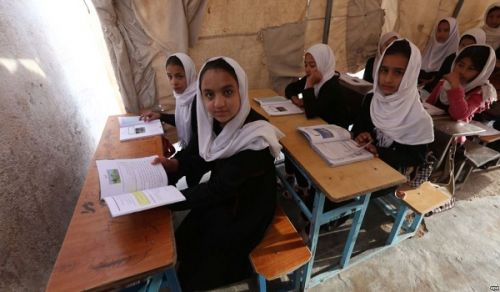
بسم الله الرحمن الرحيم
Afghanistan's Concrete Schools Serve the Colonial War
Rather than Education!
After the fall of the Taliban regime, the United States tried to claim that the educational system in Afghanistan has grown rapidly. They see the construction and rebuilding of some schools and the possibility of school attendance for a percentage of girls as their greatest success since the colonialisation. But a short overview of the Education System in the war-torn country shows that this so-called progress is only an illusion.
Afghanistan is still one of the countries where many school-age children have no access to schooling. According to the UN Children’s Agency (UNICEF), 40 percent of Afghanistan’s children are not in school. Participants in a series of Institute for War and Peace Reporting (IWPR)-organized debates said that many Afghan children are forced into hard physical labor in order to support their families, and as a result they miss out on education. Some 31 percent of the country’s children are illegally employed in heavy labor as family breadwinners. For example, around 150,000 school-age children in Nangarhar are missing out on their education due to poverty and other problems which have been caused by the war.
Hundreds of schools are closed because of security threats and some 65 percent function under the open sky. Despite research reporting that there are roughly 780 closed schools in 34 provinces, the Afghanistan Ministry of Education (MoE), claims that only a third of this number are shut. The biggest problem is the distances between villages. They are considerably long, and the journey to schools from these villages is dangerous, especially for young children and girls. This is particularly true in the rural province of Ghor, where only 29 percent of the population lives within five kilometers of a primary school. Only 28 percent of children in this province from 6-13 are enrolled in school – a rate that is similar to other rural areas in Afghanistan. The education department of Helmand reported that104 of Helmand’s 454 schools have been closed for the past three or four years. 69 shut recently because of security threats. The number of enrolled students in the province is only 192,500 including 51,867 girls. In the Zabul province 60 percent of children are unable to go to school. The worst affected are districts like Shahjoy, Daichopan, Arghandab, Shamelzi and Shinkai. In Uruzgan 60 out of 292 registered schools have been closed since 2012. In Farah around 54 of the 367 schools are closed. Going to school is also fraught with risks in provinces like Takhar, Sar-e Pol, Baghlan, Parwan, Nangarhar, Kunduz, and Badakhshan.
In addition, increasingly, the country’s security forces use schools which are the only concrete reinforced buildings in some villages, as their military bases during offensives against Taliban-held areas. For example, based on a research mission in April 2016, the occupation used 12 schools in one area of Baghlan province in north-eastern Afghanistan for military purposes. The use of schools in this way, has placed them at risk of attack and hence put students and teachers in harms’ way.
Another fact that reflects the educational crisis in Afghanistan is the general state of the schools. There are thousands of schools that function in tents and in the open air, including in Kabul. 81 of the 273 schools in the Afghan capital operate out of make-shift premises. For example, half of the schools in Kunduz do not have buildings, and the ratio is more than half in Takhar. Out of the 458 schools in Kandahar, 274 have no building. Schoolchildren in only 97 of Sar-e Pol’s 388 schools have a roof over their heads. Several schools that were built by the US Agency for International Development (USAID) in Herat lack basic needs including electricity and clean water, and have structural deficiencies that are affecting the delivery of education, according to a letter to the agency from the Special Inspector General for Afghanistan Reconstruction.
The schools provide lackluster education in broken-down buildings, and undersupplied, overcrowded classrooms, teaching for only a few hours before the next shift of students arrives. In some places (even in the capital city of Kabul) the students sit on the ground in tents and take their lessons. Teachers are frequently unqualified, some of them having never graduated high school themselves. Meanwhile, the school day in Afghanistan remains barely three hours long. Furthermore, the quality of the content in textbooks is notoriously bad, while few schools have even rudimentary science lab supplies. The teachers are often ill-equipped, badly paid, too few in numbers and increasingly unhappy about their job. A teacher's salary in Afghanistan is only around 5000 Afghanis (100 USD) per month. As a consequence, teachers demonstrated in June last year for higher wages.
Another important point is the poor state of education for girls and women in Afghanistan. Women’s literacy in Afghanistan is around 14 percent, making it amongst the lowest in the world. United Nation Educational Scientific and Cultural Organization (UNESCO), reported that 90 percent of Afghan women in rural areas are illiterate. This phenomenon is reflective of larger economic problems. Poor Afghan families often commit their young daughters to early marriage and take them out of education so they no longer have to provide for them, and, in many cases, also marry girls off for pay. The cost of supporting a daughter until she can finish her education is often too much for these families to bear. Lack of security, lack of separate sanitation facilities and gender-segregated classrooms, and a severe shortage of female teachers also deter girls’ enrollment in education. The Ministry of Education (MoE) says nearly a third of girl students drop out of school mid-way.
With this appalling state of Afghanistan’s education system as well as the general hopeless political and economic conditions and lawlessness and violence in the country, it is hardly surprising that the brain drain from this war-torn state is immense. According to the Diplomat, after 2001, there were millions of Afghan refugees living outside the country, mainly in Pakistan and Iran. They repatriated, hoping for a better life, security, and employment. UNESCO reports that approximately 17,000Afghan students studied abroad in 2013, with 9,033 (53 percent) in Iran, 2,330 (14 percent) in India, 1,310 (8 eight percent) in Turkey, 1,226 (seven percent) in Saudi Arabia, and 428 (three percent) in the US. The Washington Post stated on 13th of August 2016 that even if the government promises to create jobs for young people, it will not change the fact that the economic outlook in Afghanistan is not promising in the near future. The World Bank estimates that gross domestic product growth was 1.9 percent in 2016, which would mark the third year in a row it would be below 2 percent.These miserable conditions are therefore causing some of Afghanistan’s brightest young minds to flee from the country. President Ashraf Ghani stated that he wanted to prioritize halting brain-drain. Last year, Afghanistan’s National Unity Government started a program called Jobs for Peace to stimulate more employment and restore faith in the economy. However, a lack of funding and instability in the country will undoubtedly limit the impact of this initiative. Thus the confused young people are exposed to a hopeless future.
Education is also extremely expensive in Afghanistan and has converted into a business. There are some private schools and universities, which promise a better standard of education. Private schools and universities are often too expensive for many Afghans to afford. For instance, the American University of Afghanistan and the Swiss University (UMEF) usually charge students at the same rates as their home country (America/Switzerland). Fees for The American University of Afghanistan for example are around 18.700 AFN (about 400 USD) per credit.
Alongside this, Afghanistan in recent years has been subsequently placed among the top three nations with the most corruption by international organizations combating corruption. The Afghan police forces have arrested 7 workers of the MoE on charges of embezzling AFN 26 million.
This data about the education crises in Afghanistan demonstrates the true horrendous state in which education within the country is in. This disaster is due to the secular Western powers which pretend to be the helper of the Afghan population but in reality care only for their own colonial goals in the region. They drown the youth in the storm of confusion about education and give them false hopes and promises they can never reach in a country such as Afghanistan in its current appalling state. The corrupt governments are trying to brush this fact under the carpet, by placing the enemies as the builders of the education system in the colonialized countries. The only true way to provide a quality education to young people is through the education system of the Khilafah "Caliphate", under which education is the basic right of every individual citizen. The Khilafah "Caliphate" pursues a goal through education of preserving the strong Islamic personalities and accordingly protects the education system from anything that can harm the Islamic basis of the state or the Islamic identity of its children and people. Therefore, the revival of the Islamic education system which is possible only under the Khilafah "Caliphate" is a must for all Muslims. The deplorable state of the current education system in Afghanistan makes it clear once again that the true rise of this Ummah can only be achieved through the noble Deen of Islam and not by the colonial powers.
﴿أَفَمَنْ أَسَّسَ بُنْيَانَهُ عَلَى تَقْوَى مِنَ اللّهِ وَرِضْوَانٍ خَيْرٌ أَم مَّنْ أَسَّسَ بُنْيَانَهُ عَلَىَ شَفَا جُرُفٍ هَارٍ فَانْهَارَ بِهِ فِي نَارِ جَهَنَّمَ وَ اللّهُ لاَ يَهْدِي الْقَوْمَ الظَّالِمِينَ﴾
“Is he who founded his building upon duty to Allah and His good pleasure better; or he who founded his building on the brink of a crumbling, overhanging precipice so that it toppled with him into the fire of hell? Allah guideth not wrongdoing folk.”[At-Taubah: 109]
Written for the Central Media Office of Hizb ut Tahrir by
Amanah Abed
References:
- 1.40% children out of school
http://www.rferl.org/a/unicef-finds-40-percent-afghan-kids-out-of-school/27482592.html
- 2.Children forced hard physical labor, 150.000 children missing school in Nangarhar
https://iwpr.net/global-voices/afghan-children-forced-hard-labour
- 3.Closed schools
http://www.rawa.org/temp/runews/2016/01/09/schools-in-name-only.html
- 4.Military use of schools
- 5.General state of the schools
https://sputniknews.com/asia/201611101047311536-us-afghanistan-schools-usaid/
http://www.rawa.org/temp/runews/2016/01/09/schools-in-name-only.html
- 6.Teachers problem
- 7.Education of women
http://www.ungei.org/news/afghanistan_2343.html
http://ariananews.af/latest-news/afghan-women-have-highest-illiteracy-rate-in-country/
http://www.rawa.org/temp/runews/2016/05/06/open-the-world-of-education-to-girls.html
- 8.Brain drain
http://wenr.wes.org/2016/09/education-afghanistan
- 9.Fees of American university
https://www.auaf.edu.af/admissions/tuition-and-fees/
- 10.Corruption
http://www.khaama.com/7-education-ministry-workers-arrested-for-embezzling-afn-26-million-0579




